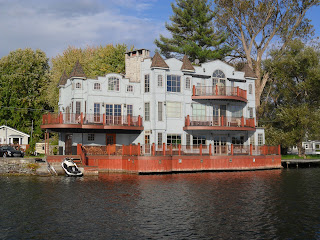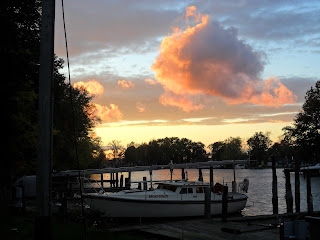As we headed out of the harbor, we were not able to see the farther shore to the north. It would be about three hours of steady motoring before we planned to be able to see the headlands at Stony Point. I had previously done some salmon fishing off Stony Point and knew that you could see the top of the cooling towers at the Nine Mile Point power station near Oswego from 30 miles away. At least we would have some visible reference off our stern to mark our progress as the southern shore of the lake disappeared below the horizon of water.
The high winds from the prior two days had put a lot of energy into the lake. Although the wind was from the south, there was a 3 foot swell coming from the southwest. Fortunately the period between wave crests was long enough that we did not experience too much roll. As long as we kept the RPMs on the engine close to 2700 we were able to make steady progress and stay ahead of the swells.
The sun began to warm our backs as we moved north. We had started the day all bundled in layers and foul weather gear. We began to relax and peel as the temperature climbed. We were 3 hours out and about 15 miles north of Oswego when trouble struck again. Just when it was feeling nice and balmy, the engine went into overheat again. I pulled the companionway ladder and saw that the main belt driving the alternator and fresh water pump was really sloppy. It had loosened further from the night before.
We stopped the engine again, but this time there was no possibility of dropping anchor. Without any headway, the boat turned sideways to the swell and began to roll. The wind was still steady from the south at 10 MPH so I grabbed a blanket and tied it to the mast spreaders and the deck. This made a small square sail and caught just enough wind to give us a little steerage.
While Niki tried to keep the bow pointed north and the swells onto the stern, I went below and tried to tighten the belt. No matter how much raw cooling water our new impeller was pushing, it could not transfer heat out of the engine, unless the fresh water circulating pump was pumping coolant through the heat exchanger. After bracing myself in the companionway against the roll of the boat, I got the alternator forced further out on its bracket, and tightened the belt that drives the alternator and fresh water pump properly. We started the engine back up again.
We were over a third of the distance across the lake. We decided to keep going at a slower speed and RPM. With our tiny little square sail adding extra push we continued further north. Around noon we were able to see a darkening edge to the far north horizon. By 1 PM we knew we were seeing Stony Point and Stony Island.
The Stony Point Lighthouse is no longer operational, but it still stands 40 feet high on the shore just below the headlands. As we moved up the shore past the headlands and cliffs of the point, we knew we were getting close to home. As soon as we entered the channel between Stony Island and Stony Point the swells decreased. So did the wind and we struck our little square sail experiment.
We started checking off the landmarks that we knew well from our previous years in Upstate. We passed the camps on Association Island at the head of Henderson Bay. Once passed Six Town Point and Lime Barrel Shoal, we could see Bass Island. We struggled to find the red mark at the end of Horse Island in the gathering overcast. We hoped to make it in before any rain began.
When we could see the grassy slopes of the War of 1812 Battleground, we knew we were just around the corner from Sackets Harbor and our new home for Broad Reach at Navy Point Marina.
When the brick buildings of the old navy Barracks came into view and we could see the masts in the harbor at Barracks Marina we started celebrating.
We made the hard turn to starboard around Navy Point and into the inner harbor at Sackets. The lights were on at the town common and bandstand. We felt like they turned them on just for us. All of our favorite restaurants were still open for business. We even had a welcoming committee of sorts. As we pulled into our slip, several large salmon that were schooled up in the marina began leaping out of the water repeatedly. They thought they were feeding on bait, but we knew they were splashing us home.
We had a lot of fun and faced a lot of challenges in making this trip north with Broad Reach. Some couples would find it hard just to be confined together on 250 square feet of deck for three weeks. All the new people we met and the new places we saw were fantastic. The best part of the trip for me was the daily reliance on each other for our comfort, safety, and peace of mind. It was a total gas experiencing every moment of this adventure together. I am blessed daily in my life with the compassion, bravery, wisdom and grace embodied in my friend and partner. Niki you can captain our boat anywhere you like, as long as we go there together.
Peace to you all from Sackets Harbor, NY!
















































